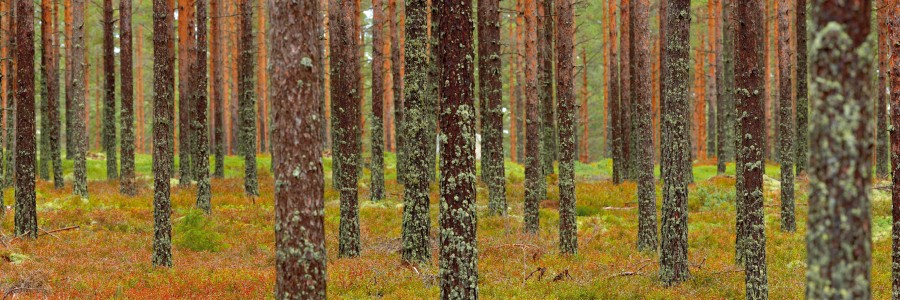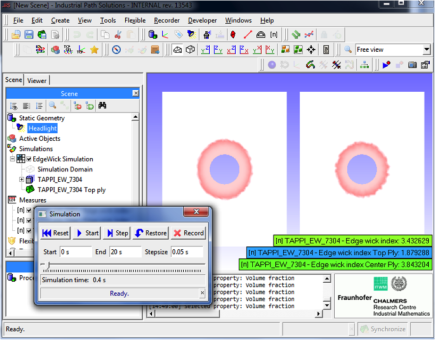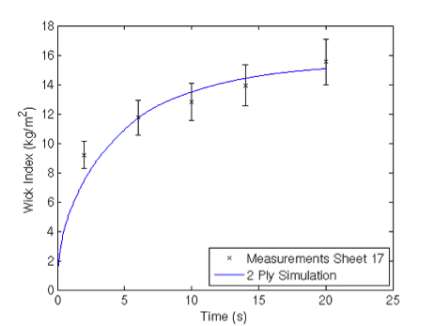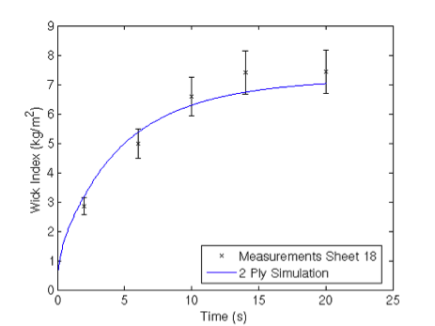The aim of the ISOP project is to develop novel tools for simulation of papermaking and paperboard package quality that are based on microstructure models of the fiber web. The project is performed together with a consortium of companies from the Swedish paper and packaging industry.
The main innovation in the ISOP project is to perform simulations on the fiber microstructure to predict macroscopic paperboard properties with industrially relevant accuracy. Substantial progress in the fundamental understanding of the papermaking process is achieved, and is particularly important to be able to develop products with increased functionality but with less material and energy input. This is crucial for the competitiveness of renewable packaging materials in order to meet the increasing threat from fossil-based packaging materials such as plastics.
The main goal of the second three-year phase, 2012-2014, was to further develop and extensively validate the software such that it can contribute to a faster, cheaper and more efficient process and product development at the companies. Our efforts focused on the simulation tools used for investigation of how the build-up of the paper in the forming section and the paperboard’s resilience to edge penetration depend on pulp, chemical and forming fabric properties, and process conditions. In the long term this means that paperboard packages with better functional properties can be developed. The software is based on an object-oriented C++ framework and consists of the following tightly coupled modules: PaperGeo for virtual structure generation, IBOFlow for fluid dynamics simulation, and LastFEM for structural dynamics. The IPS platform is used for pre- and post-processing.
Paper forming
In the paper forming section of the paper machine a fiber suspension in the form of a free jet leaves the headbox and impinges on a permeable belt called a forming fabric. The initial forming influences the properties of the fiber web and the subsequent dewatering, and depends on fiber characteristics, chemical additives, forming fabrics and other process conditions. Since the effective paper properties depend on the micro-structure a continuum model is inadequate. The fluid-structure interaction of flow and moving fibers and flocs needs to be accurately modeled in this application. The fact that the fibers are buoyant with the same density as the surrounding water makes this a very challenging problem.
Our in-house Navier-Stokes software, IBOFlow, is perfectly suited for this application. The flow around the moving fibers is resolved by the adaptive octree grid and immersed boundary methods are used to model the presence of fibers in the flow. The fibers are approximated as slender bodies represented by hollow elliptical segments. The fluid force on each fiber segment is calculated by integrating the pressure and the viscous stress tensor around the segment surface. To be able to calculate the deformation, rotation and translation of the fibers, finite-strain beam theory, including shearing is utilized and discretized in a FEM framework. The chemical and physical interactions in the fiber suspension and with the forming fabric are modeled by DLVO theory that takes electrostatic and van der Waals forces, and Born repulsion, into account. In the simulation software, individual fibers, filler and fines are generated and visualized in the process of laying down onto the forming fabric. The buildup of surface density of paper material across the forming fabric as well as fiber orientations are computed and used as a measure for comparison with experiments. In the ongoing third three-year phase, 2015-2017, the paper forming module is further developed, and the effect of pressing and drying of the sheet structure are taken into account. The resulting sheets are validated by simulation of air permeability and mechanical properties.
Product quality – Edge wicking
During startup of the Tetra Brik Aseptic (TBA) filling machine after a short stop the bath is filled with a liquid mixture of water and peroxide, and the liquid starts to penetrate the open edge of the paperboard. Only a few millimeters’ penetration can be allowed, otherwise a tube break might occur that destroys the aseptic environment in the filling machine. The resulting penetration depends on fiber properties, chemical additives, sheet structure and other process parameters.
To simulate the edge penetration, a multi-scale framework has been developed. The macro-scale model requires the relative permeabilities and capillary pressure curves for each ply from the micro-scale as an input. Small pieces of 3D paper microstructure are therefore generated using PaperGeo. For these microstructures a pore-morphology model generates active pore radius and saturation levels for different pressure drops. Using a model for the contact angle that depends on time, saturation and local chemical additive concentration, the capillary pressure curves can then be calculated. One-phase flow simulations are performed on active pores to calculate the relative permeabilities. A virtual macro board (2D distribution of surface weight and anisotropy for each ply) is then generated based on the micro properties. Two-phase porous media flow simulations on the macro board give the liquid front as a function of time in each ply. This unique multi-scale framework has been validated with stationary and transient edge wicking experiments with excellent agreement, as can be seen in the picture. These simulations have led to new insights of the process, e.g., that the diffusive meniscus must be taken into account to accurately predict the transient wicking behavior and that a random distribution of chemical additives yields a less uniform wicking.
A snapshot from the software IPS ISOP Edge Wicking. The simulation shows the penetration of liquid through the hole in a paperboard.
Validation of the transient edge wicking index for a two-ply board, without chemical additives (top), including chemical additives (below). The lower levels of edge wicking in the top figure shows the effect of adding additives to prevent liquid from penetrating into the paperboard.







